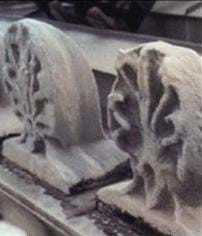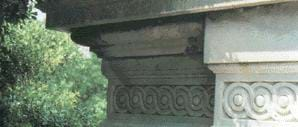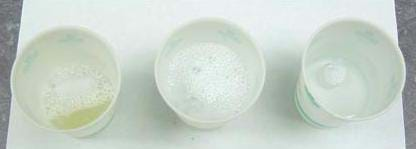Quick Look
Grade Level: 3 (3-5)
Time Required: 30 minutes
Expendable Cost/Group: US $2.50
Group Size: 3
Activity Dependency: None
NGSS Performance Expectations:

| 4-ESS2-1 |
Summary
Students explore the effect of chemical erosion on statues and monuments. They use chalk to see what happens when limestone is placed in liquids with different pH values. They also learn several engineering approaches to reduce the effects of acid rain.
Engineering Connection
Engineers consider the possible effects of acid rain on the health of humans and the environment when they investigate damage to bodies of water, wildlife, forests, crops and contamination of the drinking water supply. Engineers help to develop laws that prevent or limit large factories and industries from generating and releasing pollutants. And, they develop new technologies to help reduce air and water pollutants, such as better air cleaners and air filtration systems for industry and energy-efficient cars and appliances.
Learning Objectives
After this activity, students should be able to:
- Give examples of common acids and bases.
- Describe acid rain and chemical erosion and how they affect the environment.
- List several things that engineers are doing to reduce acid rain and its effects.
Educational Standards
Each TeachEngineering lesson or activity is correlated to one or more K-12 science,
technology, engineering or math (STEM) educational standards.
All 100,000+ K-12 STEM standards covered in TeachEngineering are collected, maintained and packaged by the Achievement Standards Network (ASN),
a project of D2L (www.achievementstandards.org).
In the ASN, standards are hierarchically structured: first by source; e.g., by state; within source by type; e.g., science or mathematics;
within type by subtype, then by grade, etc.
Each TeachEngineering lesson or activity is correlated to one or more K-12 science, technology, engineering or math (STEM) educational standards.
All 100,000+ K-12 STEM standards covered in TeachEngineering are collected, maintained and packaged by the Achievement Standards Network (ASN), a project of D2L (www.achievementstandards.org).
In the ASN, standards are hierarchically structured: first by source; e.g., by state; within source by type; e.g., science or mathematics; within type by subtype, then by grade, etc.
NGSS: Next Generation Science Standards - Science
| NGSS Performance Expectation | ||
|---|---|---|
|
4-ESS2-1. Make observations and/or measurements to provide evidence of the effects of weathering or the rate of erosion by water, ice, wind, or vegetation. (Grade 4) Do you agree with this alignment? |
||
| Click to view other curriculum aligned to this Performance Expectation | ||
| This activity focuses on the following Three Dimensional Learning aspects of NGSS: | ||
| Science & Engineering Practices | Disciplinary Core Ideas | Crosscutting Concepts |
| Make observations and/or measurements to produce data to serve as the basis for evidence for an explanation of a phenomenon. Alignment agreement: | Rainfall helps to shape the land and affects the types of living things found in a region. Water, ice, wind, living organisms, and gravity break rocks, soils, and sediments into smaller particles and move them around. Alignment agreement: Living things affect the physical characteristics of their regions.Alignment agreement: | Cause and effect relationships are routinely identified, tested, and used to explain change. Alignment agreement: |
Common Core State Standards - Math
-
Draw a scaled picture graph and a scaled bar graph to represent a data set with several categories. Solve one- and two-step "how many more" and "how many less" problems using information presented in scaled bar graphs.
(Grade
3)
More Details
Do you agree with this alignment?
-
Use a pair of perpendicular number lines, called axes, to define a coordinate system, with the intersection of the lines (the origin) arranged to coincide with the 0 on each line and a given point in the plane located by using an ordered pair of numbers, called its coordinates. Understand that the first number indicates how far to travel from the origin in the direction of one axis, and the second number indicates how far to travel in the direction of the second axis, with the convention that the names of the two axes and the coordinates correspond (e.g., x-axis and x-coordinate, y-axis and y-coordinate).
(Grade
5)
More Details
Do you agree with this alignment?
International Technology and Engineering Educators Association - Technology
-
The use of technology affects the environment in good and bad ways.
(Grades
3 -
5)
More Details
Do you agree with this alignment?
State Standards
Colorado - Science
-
Analyze and interpret observations about matter as it freezes and melts, and boils and condenses
(Grade
3)
More Details
Do you agree with this alignment?
-
Use evidence to develop a scientific explanation around how heating and cooling affects states of matter
(Grade
3)
More Details
Do you agree with this alignment?
Materials List
Each group needs:
- ½ cup tap water
- ½ cup lemon juice
- ½ cup white vinegar
- 3 pieces white chalk (larger chalk pieces with a flat surface, if possible, these are easier for the students to decorate)
- 3 small cups labeled with group names (clear plastic cups work best)
- 3 nails (or other sharp objects that could scratch chalk)
- 3 strips litmus paper
- Acid Rain Worksheet, one per student
- Acid KWL Chart, one per student
For the teacher/instructor:
- waterproof marker
- timer, such as a watch, clock or stopwatch
Worksheets and Attachments
Visit [www.teachengineering.org/activities/view/cub_earth_lesson5_activity2] to print or download.Introduction/Motivation

What do you know about acids and bases? Did you know that almost every liquid you see is an acid or a base (with the exception of distilled water, which is just water)? The amount of tiny particles—called ions—in a liquid determines whether something is categorized as an acid or a base. We use the terminology of pH to identify whether a liquid is an acid or a base.
What are some examples of acids and bases around your own home? (See if students have suggestions.) Bleach and household cleaners are examples of bases. Did you know that a really strong acid or base can break something apart? If you add straight bleach to a piece of clothing, it can take the color away or even create a hole in the fabric. Examples of common acids are lemon juice, vinegar and cola. Very strong acids can put holes in items as well. Today we are going to see what an acid can do to a basic building material, limestone.
Acids can also be found in the air around us—specifically in polluted air. Acid rain happens when air pollution chemicals, which come from fuel-burning factories and cars, react to form acids in the air. The acids from burning fuel in the air attach to water molecules in the air and fall as rain or snow. We call the breakdown caused by acid rain, chemical erosion. The effects of acid rain (chemical erosion) include: damage to statues and buildings; weakening of the exposed metal on bridges and playground equipment; damage to wildlife, plants, forests and crops; and the contamination of drinking water supplies.

Two materials often used to construct countertops and floors are limestone and marble, which both contain calcium carbonate. Many historical buildings and monuments are built of limestone and marble, such as well-known monuments in Washington DC. Acid rain is harmful to many of these monuments and buildings because the acid breaks down the calcium carbonate in the material more quickly than with other building materials. See Figures 1 and 2 for examples of acid rain chemical erosion.
Procedure
Background
Acid rain is formed by complex chemical reactions involving air pollution. The two main pollutants in acid rain are oxides of nitrogen and sulfur that react with rain moisture to form nitric and sulfuric acid. Mainly, these erosive pollutants come from human-made sources such as cars and fossil fuel-burning electrical power plants. Acid rain contaminates the environment not just through rain, but also through snow, fog, dew and dust.
In this activity, lemon juice and vinegar are the acids used to represent acid rain. Chalk, composed of limestone, represents statues in this activity. Limestone contains calcium carbonate (CaCO3), which reacts chemically with acids, causing it to deteriorate or erode. The acid causes the calcium (Ca) and carbonate (CO3) in the limestone to separate into calcium and carbon dioxide gas (CO2).
Although the lemon juice and vinegar acids used in this activity are more concentrated than acid rain, they successfully demonstrate the erosive effects of acid rain over time.
Before the Activity
- Gather supplies and make copies of the Acid Rain Worksheet and Acid KWL Chart.
- Prepare three cups for each group, one with tap water, one with lemon juice and one with vinegar. Clearly label each cup using a waterproof maker with the group name and the liquid each cup contains.
With the Students
- Hand out the worksheets and KWL charts. Have students fill in the "Know" section of the chart. Discuss how and why acid rain occurs and how acid rain can chemically erode many limestone statues and monuments. Explain that engineers work to stop acid rain by finding cleaner ways to create energy as well as modifying existing technologies (cars, industrial plants, etc.) so that less air pollution is created, and thus, less acid rain.
- Show photographs of chemical weathering. Explain that rain is typically a little acidic to begin with, but sometimes it can become even more acidic because of pollution. The amount of damage that acid rain causes depends on how acidic it is. Also explain that damage can occur with just a little bit of acidity over long periods of time. Have students complete the "Want to Know" section of the KWL chart.
- Divide the class into groups of three students each. Hand out the cups of liquid, three nails and three pieces of chalk to each group.
- Direct the students to each use a nail to carve a picture, shape or markings in one piece of chalk, which represents an outdoor statue, sculpture or building detail composed of limestone. Then, direct them draw a quick sketch of their chalk on their worksheets.
- When finished, have each group member put his/her piece of chalk in a container of liquid (as shown on Figure 3: one piece of chalk in each of the cups of water, lemon juice or vinegar) and wait 10 minutes. Start a timer to monitor the passage of 10 minutes.

- While students are waiting, have them use litmus paper to measure and record on their worksheets the pH of each of the three liquids.
- After 10 minutes, have students remove the chalk from the liquid and draw a new sketch of the changed chalk on their worksheets. How is it different than before?
- To conclude, have students compare their chalk with the chalk of other members in their group and fill out the remainder of the worksheet.
- Also have students complete the "Learned" section of the KWL chart.
Assessment
Pre-Activity Assessment
Discussion Questions: Before the activity, gauge students' base knowledge by asking them:
- What do you know about acids? (Possible answers: Acids are substances with high pH, that often taste sour, that turn litmus paper blue and can chemically break things apart.)
- Can you name any acids? (Possible answers: Lemons, vinegar, cola, car battery acid, hydrochloric acid.)
Know-Want to Know-Learn (KWL) Chart: Before the activity, ask students to each write down on the Acid KWL Chart (or in the top left corner of a piece of paper or as a group on the board) under the title, Know, all the things they know about acid rain. Next, in the top right corner under the title, Want to Know, ask students to write down anything they want to know about acid rain. After the activity, ask students to list in the bottom half of the page under the title, Learned, all of the things that they have learned about acid rain. Ask students to name a few items and write them on the board.
Activity Embedded Assessment
Prediction: Ask students to predict what will happen when they put their chalk into the liquid and record their predictions on their worksheets.
Activity Worksheet: Have students individually complete the Acid Rain Worksheet as they work through the lab experiment; review their sketches, predictions, data, graphs and answers to gauge their mastery of the subject.
Post-Activity Assessment
Question/Answer: Ask students the following questions as prompts for a class discussion:
- What causes acid rain? (Answer: Acid rain happens when air pollution chemicals—from fossil fuel-burning vehicles, factories and power plants—react to form acids in the air. The acids in the air then attach to water molecules and fall as rain or snow.)
- What effects does acid rain have on statues and monuments? (Answer: Acid rain can dissolve away statues, monuments and buildings over time.)
- How do engineers try to clean up acid rain? (Answer: Engineers work to find ways other than burning fossil fuels to harness energy, such as using wind, water and solar energy to power vehicles and generate electricity. Engineers also design filters for smoke stacks so less air pollution is released into the atmosphere from industrial factories.)
Know-Want to Know-Learn (KWL) Chart: Finish the remaining section of the Acid KWL Chart as described in the Pre-Activity Assessment section. After the activity, ask students to list in the bottom half of the page under the title, Learned, all of the things that they have learned about acid rain. Ask students to name a few items and write them on the board.
Safety Issues
As with any lab experiment, remind students to not eat or drink any of the liquids or other materials used during activity.
If using nails, remind students to use them ONLY for carving the chalk; they are not for poking or scratching people, tabletops or walls.
Troubleshooting Tips
As an alternative to nails, use a ballpoint pen or pencil tip to carve the chalk, although this may ruin the writing implement.
Expect the chalk placed in the lemon juice or vinegar to dissolve such that the carved pictures are no longer visible. If this does not happen:
- Try leaving the chalk longer in the liquid that did not dissolve the chalk.
- Try using more concentrated vinegar or lemon juice.
Activity Extensions
Extend the activity by leaving the chalk in the containers of liquid for a few days to see when/if the chalk completely dissolves. Have students record how many days it took the chalk to dissolve for each liquid and make a representative line graph of the data. Explain that this simulates the effect of acid rain over a longer period of time. Test other items in the liquids, such as leaves, metals or plastic, to see what else is affected by acid rain.
Try other common acids and bases and see what affect they have on chalk, leaves or other common items. For example, use cola (acid) or oven cleaner (base).
Make a flyer or poster about why engineers care about acid rain. For example, acid rain damages building, car paint and ecosystems. Have students draw pictures of something engineers could do to help reduce acid rain or its damage.
Subscribe
Get the inside scoop on all things TeachEngineering such as new site features, curriculum updates, video releases, and more by signing up for our newsletter!More Curriculum Like This

Students are introduced to acids and bases, and the environmental problem of acid rain. Students also conduct a simple experiment to model and discuss the harmful effects of acid rain on our living and non-living environment.

Students are introduced to the primary types of erosion—chemical, water, wind, glacier and temperature. Students investigate examples of each erosion type and discuss how erosion changes the surface of the Earth.

Students are introduced to the differences between acids and bases and how to use indicators, such as pH paper and red cabbage juice, to distinguish between them. They learn why it is important for engineers to understand acids and bases.

Through this hands-on activity, students explore five different forms of erosion: chemical, water, wind, glacier and temperature. They rotate through stations and model each type of erosion on rocks, soils and minerals.
References
McGee, Elaine. U.S. Department of the Interior, U.S. Geological Survey, "Acid Rain and Our Nation's Capitol," July 21, 1997. Accessed November 9, 2020. http://pubs.usgs.gov/gip/acidrain/
Copyright
© 2006 by Regents of the University of ColoradoContributors
Jessica Todd; Melissa Straten; Malinda Schaefer Zarske; Janet YowellSupporting Program
Integrated Teaching and Learning Program, College of Engineering, University of Colorado BoulderAcknowledgements
The contents of this digital library curriculum were developed under grants from the Fund for the Improvement of Postsecondary Education (FIPSE), U.S. Department of Education and National Science Foundation (GK-12 grant no. 0338326). However, these contents do not necessarily represent the policies of the Department of Education or National Science Foundation, and you should not assume endorsement by the federal government.
Last modified: November 9, 2020









User Comments & Tips